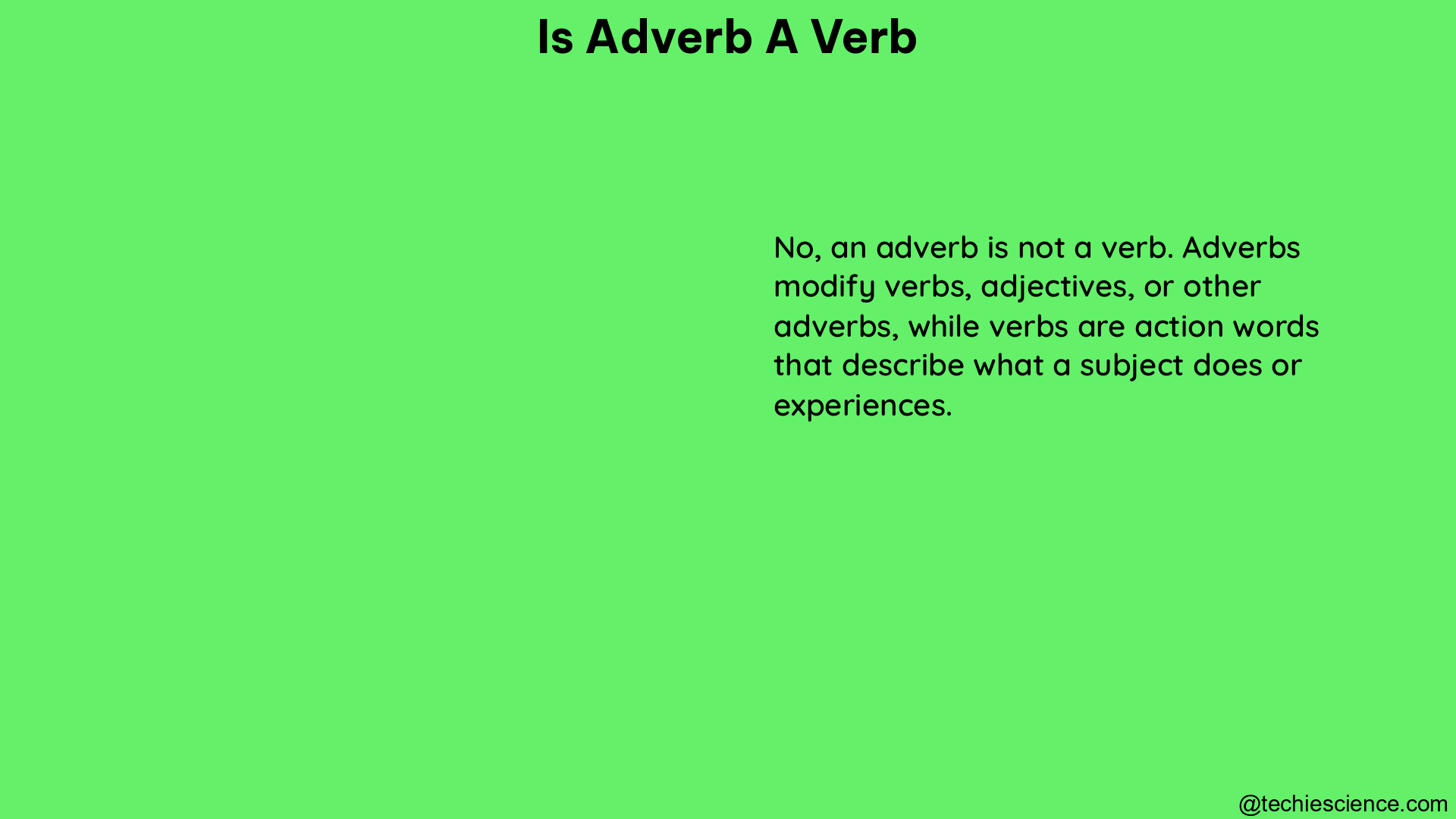Adverbs and verbs are two distinct parts of speech in the English language, each serving a unique purpose in sentence construction. While both play crucial roles in conveying meaning, it’s essential to understand the fundamental differences between these grammatical elements. In this comprehensive guide, we’ll delve into the intricate details that distinguish adverbs from verbs, providing you with a thorough understanding of their functions, characteristics, and practical applications.
The Function of Verbs
Verbs are the essential building blocks of a sentence, expressing actions, occurrences, or states of being. They are the main part of a sentence, indicating what the subject is doing or experiencing. Verbs can be conjugated to reflect tense, voice, or mood, allowing for a dynamic and nuanced representation of events. Examples of verbs include “run,” “jump,” “think,” “be,” “seem,” and “become.”
The Function of Adverbs

Adverbs, on the other hand, serve a different purpose. They are used to modify verbs, adjectives, or other adverbs, providing additional information about the manner, time, place, degree, frequency, or certainty of the action or state being described. Adverbs do not change form to reflect tense, voice, or mood, as they are primarily concerned with enhancing the meaning of the words they modify. Examples of adverbs include “quickly,” “slowly,” “well,” “now,” “then,” “very,” “too,” and “enough.”
Identifying Verbs and Adverbs
To distinguish verbs from adverbs, it’s essential to focus on their respective functions within a sentence. Verbs express action or state of being and are often the main event or occurrence in a sentence. Adverbs, in contrast, modify verbs, adjectives, or other adverbs, providing supplementary information about the action or state being described.
Verb Identification
Verbs can be identified by their ability to express action or state of being. They are the central elements that convey the main idea or event in a sentence. Verbs can be conjugated to reflect tense, voice, or mood, allowing for a dynamic representation of events. Examples of verbs include:
- “She runs quickly to the store.”
- “The cat was sleeping peacefully on the couch.”
- “They will have completed the project by tomorrow.”
Adverb Identification
Adverbs, on the other hand, are identified by their ability to modify verbs, adjectives, or other adverbs. They provide additional information about the manner, time, place, degree, frequency, or certainty of the action or state being described. Adverbs do not change form to reflect tense, voice, or mood. Examples of adverbs include:
- “The athlete sprinted swiftly across the finish line.”
- “The weather is unusually warm today.”
- “She speaks French fluently.”
Types of Adverbs
Adverbs can be further classified into different categories based on the type of information they provide. These categories include:
- Adverbs of Manner: Describe how something is done (e.g., quickly, loudly, carefully).
- Adverbs of Time: Indicate when something happens (e.g., now, yesterday, tomorrow).
- Adverbs of Place: Indicate where something happens (e.g., here, there, everywhere).
- Adverbs of Degree: Describe the intensity or quality of an action (e.g., very, extremely, slightly).
- Adverbs of Frequency: Indicate how often something happens (e.g., frequently, sometimes, rarely).
Understanding these different types of adverbs can help you effectively use them in your writing and speech to convey precise and nuanced meanings.
Adverbs and Verbs in Sentence Construction
The interplay between adverbs and verbs is crucial in creating well-structured and expressive sentences. Let’s examine some examples to illustrate their roles:
- Verb Example: “She reads the book.” (Verb: reads)
- Adverb Example: “The cat crept silently up to the mouse.” (Adverb: silently)
In the first example, the verb “reads” is the central action being performed by the subject “she.” In the second example, the adverb “silently” modifies the verb “crept,” providing additional information about the manner in which the cat approached the mouse.
By understanding the distinct functions of adverbs and verbs, you can craft sentences that convey your intended meaning with clarity and precision.
Conclusion
In summary, adverbs and verbs are two separate parts of speech that serve different grammatical functions. Verbs express actions, occurrences, or states of being, while adverbs modify verbs, adjectives, or other adverbs, providing additional information about the action or state being described. Recognizing the differences between these two elements is crucial for effective communication and clear sentence construction.
References
- Verb vs. Adverb: Understanding the Differences
- Merriam-Webster Dictionary: Adverb
- Verbs vs. Adverbs: What’s the Difference?
- What Is an Adverb?
- Verb vs. Adverb: Understanding the Differences

Hi! I am Bhabesh Sing. I have completed M.A in English, M.A in Vocal Music, and B.Ed. I am a creative writer. Currently, I am a Subject Matter Expert in English on this Platform.
Let’s connect through LinkedIn-https://www.linkedin.com/in/bhabesh-sing-660914ab